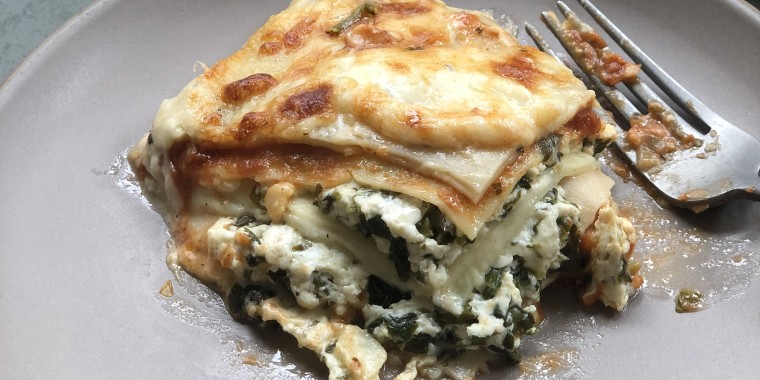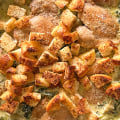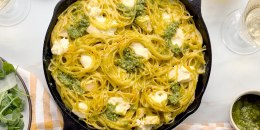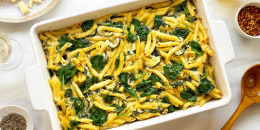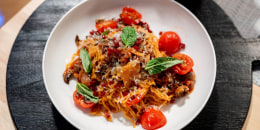Chef notes
Delicate sheets of handmade pasta are layered with rich béchamel, savory tomato sauce and creamy ricotta filling, and studded with spinach and herbs, in this deeply comforting lasagna. But if you don't have the time to make each component or can't find all of the ingredients, use fresh or dried store-bought noodles and avail yourself of the many suggested substitutions. For a vegan version, use cashew milk and vegan butter to make béchamel, vegan cheese and cashew ricotta for the filling, and make sure to buy dried pasta that does not contain eggs. No matter how you make this dish, you'll find that it's grand, comforting and perfect for sharing with whoever is around.
This recipe was reprinted with permission from NYT Cooking. Watch Nosrat make #TheBigLasagna on YouTube or IGTV.
Ingredients
- 6 tablespoons extra-virgin olive oil
- 5 cups diced yellow onions, red onions or shallots
- Fine sea salt
- 1 (28-ounce) can whole peeled, diced, crushed or puréed tomatoes
- 4 cloves garlic, thinly sliced
- 2 tablespoons tomato paste (optional)
- 4-5 basil stems (optional)
- 1/4 teaspoon crushed red pepper flakes (optional)
- 4 cups "00" or all-purpose flour, plus more for dusting
- 4 whole large eggs
- 5-6 large egg yolks
- 4 tablespoons extra-virgin olive oil (if using fresh spinach)
- 1 pound fresh mature spinach, washed and ends trimmed, 1 pound baby spinach or 1½ cups frozen spinach, thawed
- Fine sea salt
- 2 pounds whole-milk or part-skim ricotta (about 4 cups)
- 6 ounces grated whole-milk or part-skim mozzarella, provolone or even string cheese (2 cups)
- 3 ounces freshly grated Parmesan, Asiago or Grana Padano (1 heaping cup)
- 20 large fresh basil leaves (from 1 bunch), finely chopped (about 3/4 cup), 2 tablespoons finely chopped fresh Italian parsley or chives, 1 teaspoon finely chopped fresh thyme or marjoram or 1 teaspoon dried Italian seasoning
- 1/2 cup (1 stick) unsalted butter
- 1/2 cup all-purpose flour
- 4 cups whole milk
- Fine sea salt
- Freshly ground black pepper
- Ground nutmeg (optional)
- 4½ cups Simple Tomato Sauce or 32 ounces store-bought marinara sauce (preferably without added sugar)
- Fine sea salt
- 1 recipe Handmade Lasagna Sheets, 16 fresh store-bought lasagna sheets, two 9-ounce packages dried lasagna noodles (preferably without curly edges) boiled until al dente or no-boil noodles
- 1½ ounces grated Parmesan, Asiago or Grana Padano (1/2 cup)
- 3 ounces grated whole-milk or part-skim mozzarella, provolone or even string cheese (1 cup)
Preparation
For the Simple Tomato Sauce:
1.Set a medium Dutch oven or similar pot over medium heat and add 4 tablespoons olive oil. When the oil shimmers, add onions and a pinch of salt. Reduce heat to medium-low and cook, stirring regularly, until onions are lightly golden and tender, 16 to 18 minutes.
2.In the meantime, pour the tomatoes into a large bowl and use hands to crush, if using whole tomatoes. Pour about 1½ cups water into the can and swirl to rinse any remaining purée off the sides. Add the water to tomatoes in bowl and set aside.
3.Once onions are soft and golden, add garlic and cook, stirring, until it threatens to turn golden, about 90 seconds. Add tomato paste, if using, and cook until color deepens, about 3 minutes. Add tomatoes and season with salt. If using, add basil stems and red-pepper flakes. Stirring regularly, allow sauce to come to a boil, then reduce heat to low, cover and simmer until sauce tastes savory and all raw tomato flavor is gone, about 45 minutes.
4.Taste and adjust seasoning with salt and add remaining 2 tablespoons oil. Use a hand blender to purée, pass through a food mill or let cool, then purée using a blender or food processor. Tomato sauce can be made 1 day in advance and refrigerated or frozen up to 3 months.
For the Handmade Lasagna Sheets:
1.Mound the flour in the center of a large mixing bowl. Dig a well in the center of the mound and add the whole eggs and 5 yolks. Using a fork, beat together the eggs and begin to incorporate the flour, starting with the inner rim of the well. The dough will start to come together in a shaggy mass when about half the flour is incorporated.
2.Use your fingers to continue to mix the dough. Press any loose bits of flour into the dough. If needed, add another egg yolk or a tablespoon of water to absorb all of the flour.
3.Once the dough comes together into a cohesive mass, remove it from the bowl and transfer it to a lightly floured surface. Knead the dough by hand until smooth, elastic and uniform in color, 4-5 minutes. Wrap the dough in plastic and set aside at room temperature for at least 30 minutes (or up to 4 hours).
4.Line a baking sheet with parchment paper and lightly dust with flour. Set aside.
5.Cut off a quarter of the dough. Rewrap the larger portion and set aside. Use the heel of your hand to flatten the small piece of dough into an oval approximately the same width as your pasta machine, about 6 inches wide. Set the rollers to their widest setting and pass the dough through.
6.Lay the dough out onto a lightly floured cutting board or countertop and neatly press together into halves, so it's again about the same width of the pasta machine. Feed the pasta through again at the widest setting. Think of these first rollings as an extended kneading. Continue to fold the dough in thirds and roll it until it is smooth, silky and even-textured. Do your best to make the sheet the full width of the machine.
7.Once the dough is silky and smooth, you can begin to roll it out more thinly. Roll it once through each of the next two or three settings, adding flour as needed, until the dough is about 1/4-inch thick.
8.Once the pasta is about 1/4-inch thick, begin rolling it twice through the next thinner settings. As you roll, lightly sprinkle flour on both sides of the pasta to prevent it from sticking to itself.
9.Roll out pasta until you can just see the outline of your hand when you hold it under a sheet, about 1/16-inch thick. (On most machines, you won't make it to the thinnest setting.)
10.Cut pasta into sheets, about 13 inches long. Dust the sheets lightly with flour, stack on the prepared baking sheet and cover with a clean, lightly dampened kitchen towel. Repeat with remaining dough.
For the ricotta filling:
1.If using fresh spinach, set a large skillet over high heat. (If using thawed frozen spinach, skip to Step 2.) When hot, add 2 tablespoons oil and half the fresh spinach. Season with a pinch of salt and sauté to wilt. Cook until stems are tender, about 3 minutes. Transfer to a baking sheet and allow to cool in a single layer. Repeat with remaining spinach.
2.While spinach cools, combine ricotta, mozzarella, Parmesan, basil and a generous pinch of salt in a large bowl.
3.Taking handfuls of the cooled or thawed spinach, squeeze out as much water as possible, then chop finely and add to cheese mixture. Mix thoroughly, then taste and adjust seasoning for salt. (Filling makes about 6 cups.) Cover and set aside until ready to assemble lasagna. (Ricotta filling can be made 1 day in advance and refrigerated. Bring to room temperature before assembling lasagna.)
For the béchamel:
Set a large, heavy-bottomed pot or Dutch oven over medium heat and add butter. Once butter has melted, whisk in flour, reduce heat to very low and cook for about 15 minutes, stirring regularly to prevent browning. After the mixture foams a bit, it will visibly transform — the butter will separate, the bubbles will reduce in size, and the mixture will look like freshly wet fine sand. Whisking vigorously, slowly pour in milk. Increase heat to medium and whisk until the mixture thickens, about 2 minutes. Add salt, pepper and nutmeg (if using) to taste.
Return heat to low. Continue cooking, whisking regularly, for 10-15 minutes until the sauce is thick and smooth, with no raw flour flavor. Taste and adjust seasoning with salt. If béchamel is lumpy, strain through a fine sieve or purée with an immersion blender. (You'll have about 3½ cups.) Press a piece of parchment or plastic against the surface of the sauce to prevent a skin from forming and set aside until ready to assemble lasagna. (Béchamel can be made up to 1 day in advance, covered directly and refrigerated. Return to room temperature before using.)
For the lasagna:
1.Position the highest rack in the oven so that it sits about 6 inches below the top. Heat oven to 400°F.
2.If tomato sauce, béchamel and ricotta filling are cold, bring to room temperature or warm them as needed.
3.Set a large pot of water over high heat. Cover and bring to a boil. Set a large colander in a baking dish and place near stove.
4.Season the boiling water generously with salt until it tastes like sea water. Carefully lay one sheet of pasta on the water's surface. Let it be completely immersed in the boiling water, using a slotted spoon to gently push it down if needed, before adding the next sheet. Add two more pasta sheets in this way and cook for about 2 minutes, or until light in color, floppy in texture and completely cooked through. If pasta bubbles above the water's surface, use a slotted spoon to encourage it back in. Use a sieve to gently remove pasta from the water and into the prepared colander. Rinse under cold water until cool enough to handle, then begin assembly. Continue cooking, draining and rinsing pasta two or three sheets at a time as you assemble lasagna.
5.Spoon about 3/4 cup béchamel into a 9- by 13-inch metal, glass or ceramic baking pan, and use a rubber spatula or your hands to generously coat bottom and sides of pan with sauce.
6.Gently squeezing any remaining water from the pasta, use two or three sheets to entirely cover the bottom of the pan with minimal overlap, and leave ends hanging over sides. (They'll be helpful for sealing the top.) All four sides need not have overhang; two is plenty.
7.Crumble about 1/3 of the ricotta mixture evenly over pasta to create foundation, then layer with sheets of pasta from edge to edge of pan. Use kitchen shears to help trim pasta to appropriate size and avoid overlap.
8.Spread about 1/3 of the tomato sauce over next layer and cover with pasta.
9.Spread about 1 cup béchamel evenly over next layer, sprinkle with 1/4 cup grated Parmesan and cover with pasta.
10.Repeat with remaining layers: ricotta, tomato sauce, béchamel and Parmesan, ricotta, tomato sauce, béchamel and Parmesan, following each with a layer of pasta. (If using thicker noodles, you might not be able to fit 8 layers of noodles in the pan. If using store-bought or dried pasta, you can skip the noodle layer between the ricotta and tomato sauce as needed to prevent the lasagna from stretching higher than the top of the pan.)
11.For the top, fold overhanging pasta over a whole sheet to create a sealed pasta layer, then spread with remaining béchamel. Gently cover lasagna with a piece of parchment and wrap tightly with foil. Place onto a baking sheet to catch any overflow and bake on prepared rack.
12.After 40 minutes, pull lasagna from oven and carefully remove foil and parchment. Sprinkle with grated mozzarella and return to oven until golden brown and bubbling on surface, about 20 minutes.
13.Allow to cool for at least 15 minutes before slicing and serving. Leftover lasagna can be wrapped and refrigerated for up to 4 days. To freeze, bake 30 minutes but do not brown, then cool, and freeze for up to 4 weeks. Defrost, then sprinkle with mozzarella and bake uncovered at 400°F for 25-30 minutes until golden brown and bubbling on surface.
